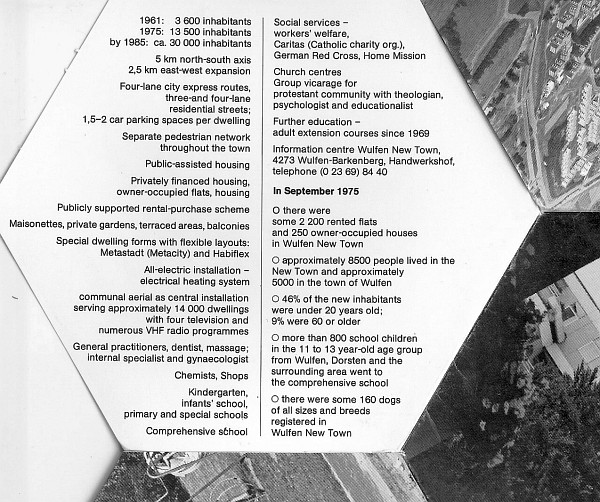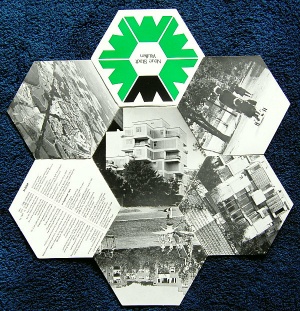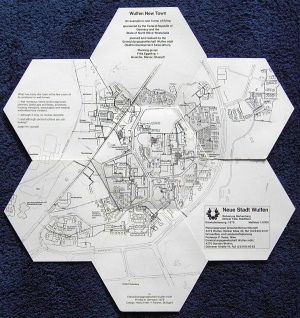The new town of Wulfen: Unterschied zwischen den Versionen
Cgru (Diskussion | Beiträge) erg. um Text des Waben-Prospektes |
Cgru (Diskussion | Beiträge) Engl.Wabenprospekt, Vorder- und Rückseite, 75 |
||
| Zeile 22: | Zeile 22: | ||
==Wulfen New Town : Faltprospekt der EW 1975== | ==Wulfen New Town : Faltprospekt der EW 1975== | ||
[[Bild:Wabeenglisch.jpg|framed|Ausschnitt aus engl. Faltprospekt der EW, 1975]] | [[Bild:Wabeenglisch.jpg|framed|Ausschnitt aus engl. Faltprospekt der EW, 1975]] | ||
[[Bild:Wabe1.jpg|thumb|]] | |||
[[Bild:Wabe2.jpg|thumb|]] | |||
Außer der als Bild wiedergegebenen Wabe enthält der Prospekt noch folgende englischsprachige Informationen : | Außer der als Bild wiedergegebenen Wabe enthält der Prospekt noch folgende englischsprachige Informationen : | ||
Version vom 16:10, 21. Mär 2008
The new town of Wulfen owes its existence primarily to the current population explosion and the rapid industrial growth in the northern - hitherto underdeveloped - area of the Ruhr District. Wulfen is situated north of the river Lippe on the southern outskirts of the Münsterland near the towns of Dorsten, Marl and Haltern and close to the Hohe Mark Nature Preserve.
The completion of a coal-mining plant - the first to be built north of the Lippe river [sic!] - was the specific reason for the foundation of Wulfen, which is intended to effect a vital improvement in the residential and industrial structure of the Lippe area. It is hoped that it will check the current exodus of skilled workers in this part of the Ruhr District and that it will prevent the land from being divided into countless uneconomically small built-up areas.
In 1967, the first flats were occupied at Barkenberg. Today, Barkenberg has 4,500 inhabitants with schools, kindergartens and retail shops.
The plan of Wulfen was the subject of an international competition won by Professor Eggeling of Berlin. The work subsequently done by many experts of various disciplines has been based an his idea of a bustling and lively town of 50,000 inhabitants which is in complete harmony with its scenic environment.
Wulfen´s location near the Hohe Mark Nature Preserve provides an ideal setting, undisturbed by highway traffic or industrial pollution, and with high recreational value.
Within the town air pollution has been avoided by utilizing electrical heat. Smokeless energy supply enhaces the "longevity" of the buildings, as well as raising the quality of life in this town. Wulfen´s skyline is not only without chimneys, but also without TV antennas by utilizing one collective antenna and providing a cable from it to each dwelling.
Motor lanes and sidewalks for pedestrians are completly seperated from each other. This leaves vast peaceful urban areas free from the hazards of heavy road traffic, while providing short and safe walkways to the most important municipal institutions, such as kindergartens, schools, retail shops, and the adjacent recreation areas.
The natural setting was preserved within the town through preservation of scenic landmarks, including controls fining builders for cutting down mature trees. Park strips alterning with built-up sites, tall buildings with flat ones, densely built-up areas with less densely built areas, multi-storeyed houses with bungalows, provide variety in the built environment.
Sociologically the architects also planned for variety by mingling sizes of units within one and the same building. For example, the ground floor is generally reserved for large flats with a garden for families with children.
Der Autor Paul Otto Schulz war ein Mitarbeiter der Hamburger PR-Agentur Lutz Böhme, die für die Entwicklungsgesellschaft Wulfen tätig wurde. Erschienen ist der Aufsatz im Juli 1973 in der Zeitschrift EKISTICS (Verlagsort Athen!), Heft 212, Seite 64 bis 66. (Vorhanden in der Stadt- und Schulbibliothek, Wu-Fa 73ZM.)
Wulfen New Town : Faltprospekt der EW 1975



Außer der als Bild wiedergegebenen Wabe enthält der Prospekt noch folgende englischsprachige Informationen :
Wulfen New Town : An example of new forms of living, sponsored by the Federal Republic of Germany and the State of North-Rhine-Westphalia, planned and realised by the Entwicklungsgesellschaft Wulfen mbH (Wulfen Development Association). Planning Group: Fritz Eggeling+ / Grosche, Börner, Stumpfl.
What has made this town in the few years of its existance so well-known?
- that numerous native and foreign town planners, landscape architects, housing managers, sociologists and medical authorities have visited it,
- although it is by no means complete,
- and although certain facilities are still lacking?
Judge for yourself.
"Habiflex" offers, in its "Gelsenkirchen balcony" and its lightweight space-divider, /fixed only at the two ends and with a number of flexible joints along its lenght), a versatile instrument, applicable to most situations where an adaptable romm shape is desired.